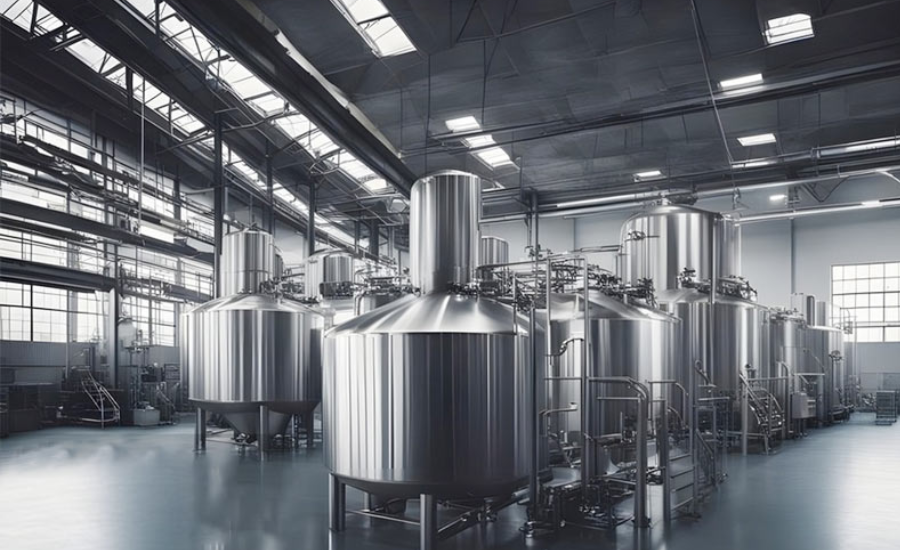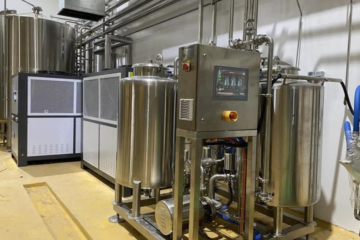Brewing beer involves various equipment, categorised into three main types: hot-side, cold-side, and packaging equipment. Each type plays a crucial role in the brewing process.
Hot-side Brewing Equipment
This equipment is used during the initial brewing stages where heat is applied.
- Mash Tun: This vessel mixes crushed malted barley with hot water to convert starches into fermentable sugars, forming the wort.
- Lauter Tun: Used to separate the liquid wort from the spent grains, ensuring a clear wort.
- Boil Kettle: The wort is boiled here, with hops added for bitterness, flavour, and aroma, and the wort is sterilised.
- Hot Liquor Tank: Stores and heats water for mashing and sparging.
Cold-side Brewing Equipment
Used after boiling, this equipment focuses on fermentation and conditioning.
- Fermentation Vessels: Yeast is added to the cooled wort here to begin fermentation, producing alcohol and carbon dioxide.
- Bright Beer Tanks: Post-fermentation, beer is transferred here for conditioning and clarification, resulting in clear beer.
- Heat Exchanger: Rapidly cools the boiled wort before it enters the fermentation vessel to prevent contamination.
- Cold Liquor Tank: Stores cold water or glycol used in the heat exchanger for efficient wort cooling.
Packaging Equipment
Essential for preparing the beer for distribution and consumption.
- Bottling Line: Fills bottles with beer, caps or seals them, and applies labels for distribution.
- Canning Line: Similar to the bottling line but for cans, ensuring durability and portability.
- Kegging Equipment: Fills kegs with beer, used for draft systems in bars and restaurants, maintaining beer freshness.
Quality Control Instruments: Ensure that each package meets quality standards and regulatory requirements.
Understanding these three types of brewing equipment highlights the complex process of transforming raw ingredients into finished beer, ensuring efficiency, safety, and consistency in production. commercial brewing equipment
1. What are the primary pieces of hot-side brewing equipment?
Hot-side brewing equipment refers to the machinery used during the initial stages of brewing, where heat is applied to the ingredients to extract flavours and convert starches to sugars.
Mash Tun: The mash tun is the vessel where crushed malted barley is mixed with hot water, initiating the mashing process. This step converts starches into fermentable sugars, forming the wort.
Lauter Tun: The lauter tun follows the mash tun. It separates the liquid wort from the spent grains, ensuring that the wort is clear and free of grain particles.
Boil Kettle: In the boil kettle, the wort is boiled, and hops are added to impart bitterness, flavour, and aroma. The boiling process also sterilises the wort.
Hot Liquor Tank: The hot liquor tank stores and heats water used in the brewing process, particularly for mashing and sparging (rinsing the grains to extract additional sugars).
2. What are the key components of cold-side brewing equipment?
Cold-side brewing equipment is used after the wort has been boiled and cooled, focusing on fermentation and conditioning.
Fermentation Vessels: Fermentation vessels, often made of stainless steel, are
where yeast is added to the cooled wort to begin fermentation. Yeast consumes the sugars, producing alcohol and carbon dioxide.
Bright Beer Tanks: After fermentation, the beer is transferred to bright beer tanks for conditioning. These tanks allow any remaining yeast and particulates to settle, resulting in a clear, bright beer.
Heat Exchanger: A heat exchanger rapidly cools the boiled wort before it enters the fermentation vessel, preventing contamination and preparing the wort for yeast addition.
Cold Liquor Tank: This tank stores cold water or glycol used in the heat exchanger to cool the wort efficiently.
3. What equipment is essential for packaging beer?
Packaging equipment is crucial for getting the final product to consumers in a stable, transportable form.
Bottling Line: A bottling line includes machines for filling bottles with beer, capping or sealing them, and labelling. It ensures that the beer is properly packaged and ready for distribution.
Canning Line: Similar to a bottling line, a canning line fills cans with beer, seals them, and applies labels. Cans are increasingly popular due to their durability and portability.
Kegging Equipment: Kegging equipment is used to fill kegs with beer, which are often used for draft beer systems in bars and restaurants. Kegs are sealed and pressurised to maintain the beer’s freshness.
Quality Control Instruments: Quality control instruments, such as CO2 testers, seam inspection systems, and fill level detectors, ensure that each package meets quality standards and regulatory requirements. Understanding the three types of brewing equipment—hot-side, cold-side, and packaging equipment—provides insight into the complex process of brewing beer.
Each category plays a vital role in transforming raw ingredients into the final product. From mashing and boiling to fermentation and packaging, specialised equipment ensures that beer is produced efficiently, safely, and consistently, meeting the high standards expected by consumers. commercial brewing equipment.
Read More: Gossips




